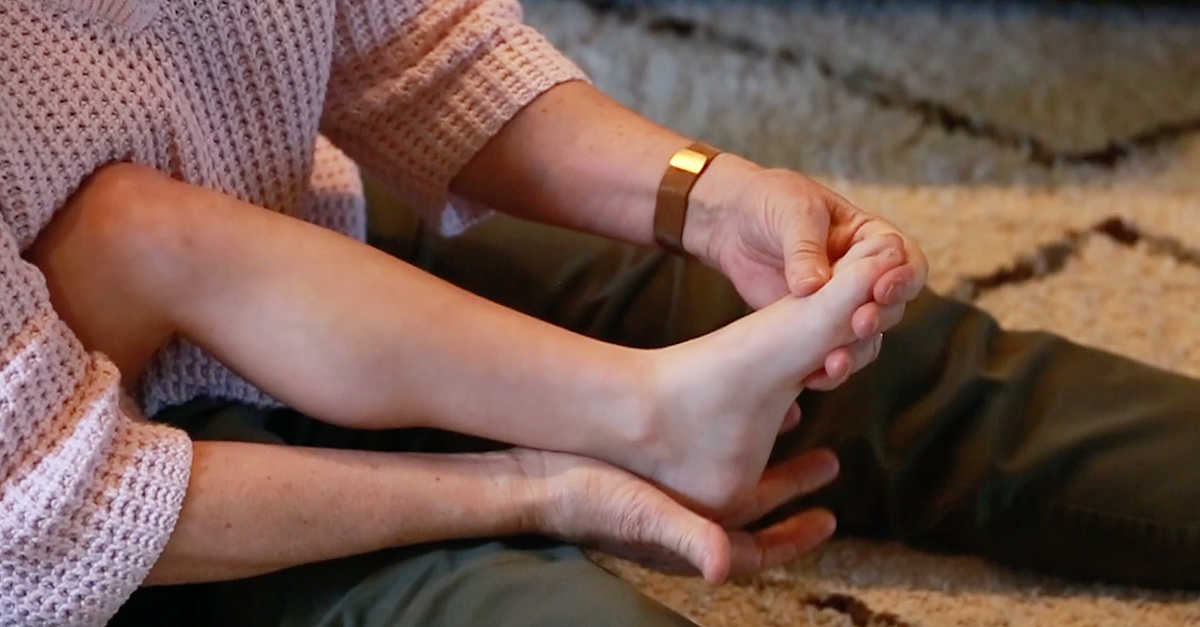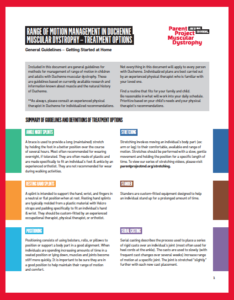
PPMD is pleased to announce that Muscle & Nerve has published an article summarizing the “Contractures in Duchenne and Other Neuromuscular Conditions” conference hosted by PPMD with the National Institute of Neurological Disorders and Stroke (NINDS) and National Institute of Child Health and Human Development (NICHD) and the Shirley Ryan Ability Lab.
In addition to the published article, PPMD worked with a team of expert Physical Therapists (PTs) to develop an easy-to-follow Range of Motion handout for parents and physical therapists.
Download Range of Motion Guide (PDF)Contractures cause significant burdens for people living with Duchenne and their families. Contracted knees, ankles, and hips make it difficult for patients to be positioned comfortably in wheelchairs or beds; contracted wrists and hands make activities of daily living difficult to do independently. Most Duchenne families are given stretching prescriptions that they are encouraged to follow at least daily to prevent contractures from forming. But no matter what parents do, some contractures seem inevitable.
PPMD Hosts Critical Meeting
In order to better understand how contractures develop, and the best ways to prevent them, PPMD convened a research conference August 19-20, 2018 in Chicago with physical therapists, physicians, and researchers from the Certified Duchenne Care Centers (CDCCs), as well as the Shirley Ryan Ability Lab (Chicago, IL) and both the National Institute of Neurological Disorders and Stroke (NINDS) and National Institute of Child Health and Human Development (NICHD).
The purpose of the conference was to discuss contractures in Duchenne and other neurologic conditions, potential biomarkers, and therapeutic strategies. To illuminate the importance of this issue, Debi McCrea, mother of Anthony, presented on both the impact of contractures, as well the daily tasks that parents are given to prevent them. While most families will follow professional recommendations as closely as possible, she encouraged professionals to let parents know that, for some patients, contractures will develop regardless of the efforts to prevent them, relieving parents of the guilt that so often accompanies contracture development.
Several take-aways of the conference included:
- Changes in walking (or gait) may increase the risk of contracture development during ambulation
- Muscle weakness and staying in the same position too long, or being in the same position too frequently, may lead to contractures after loss of ambulation
- Periodic stretching does not seem to prevent contractures, but does increase blood flow and comfort of muscles
- Prolonged stretching (orthotics) does seem to delay, and possibly prevent, contracture development, but needs further study
To better understand contractures, recommendations for the future include further study of:
- genetic factors (are certain genetic mutations more likely to develop contractures?)
- environmental factors (do positioning, stretching, orthotics, physical therapy help delay or prevent contractures?)
- biomarkers (are there biomarkers that could let us know if contractures are developing or worsening?)
PT Range of Motion Management Document for Parents and Professionals
Following this critical conference, a group of physical therapists (PTs) with expertise in Duchenne, led by Claudia Senesac, PT, PhD, PCS (University of Florida), formed a working group to discuss best practices. Most of the PTs in this working group were from PPMD Certified Duchenne Care Centers. They worked over the past year to create a comprehensive Range of Motion guide discussing general guidelines for maintaining and optimizing range of motion in children and adults with Duchenne. This document is both for parent and PT use.
The information in the PT document is based on current available research and information about the muscle and natural history of Duchenne. The PT document includes guidelines and treatment options for the following categories:
- Ankle Night Splints
- Stretching
- Resting Hand Splints
- Stander
- Positioning
- Serial Casting
It is important to note that not everything in this document will apply to every person with Duchenne. Individualized plans are best carried out by an experienced physical therapist who is familiar with your loved one. We recommend finding a routine that fits for your family and child. Be reasonable in what will work into your daily schedule and prioritize based on your child’s needs and your physical therapist’s recommendations.
Download Range of Motion Guide (PDF)


 by: Parent Project Muscular Dystrophy
by: Parent Project Muscular Dystrophy


